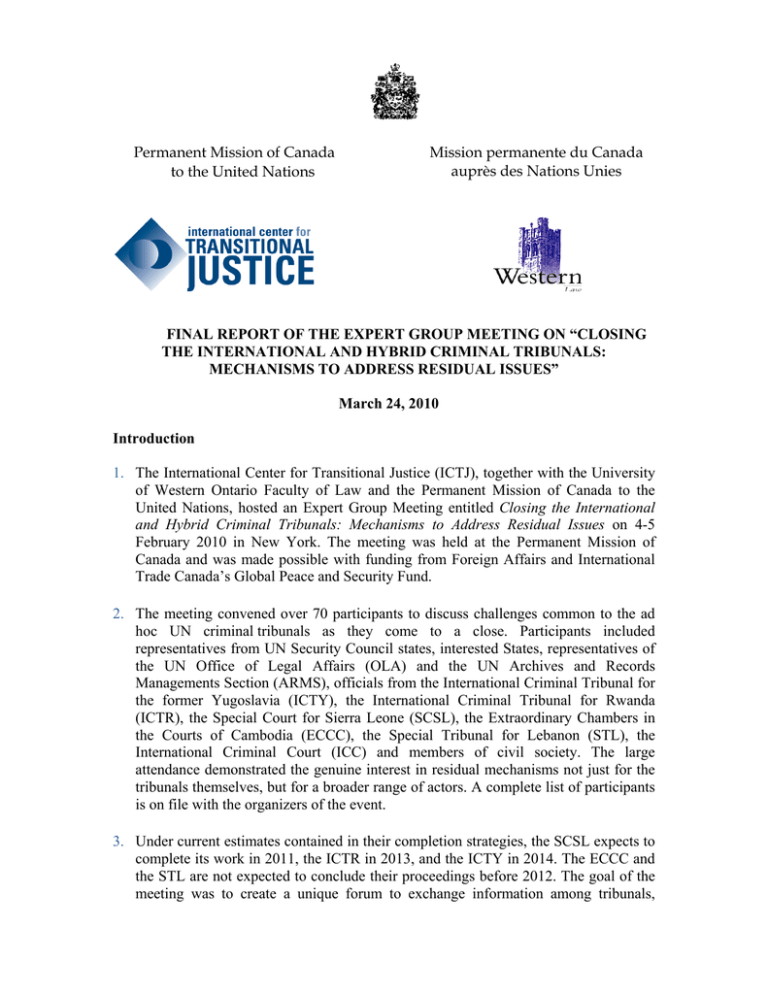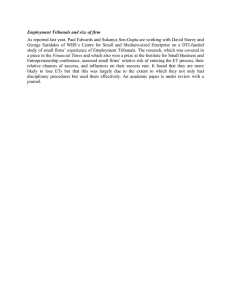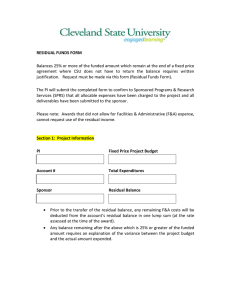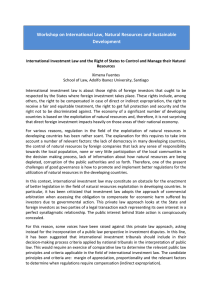Mission permanente du Canada Permanent Mission of Canada to the United Nations
advertisement

Permanent Mission of Canada to the United Nations Mission permanente du Canada auprès des Nations Unies FINAL REPORT OF THE EXPERT GROUP MEETING ON “CLOSING THE INTERNATIONAL AND HYBRID CRIMINAL TRIBUNALS: MECHANISMS TO ADDRESS RESIDUAL ISSUES” March 24, 2010 Introduction 1. The International Center for Transitional Justice (ICTJ), together with the University of Western Ontario Faculty of Law and the Permanent Mission of Canada to the United Nations, hosted an Expert Group Meeting entitled Closing the International and Hybrid Criminal Tribunals: Mechanisms to Address Residual Issues on 4-5 February 2010 in New York. The meeting was held at the Permanent Mission of Canada and was made possible with funding from Foreign Affairs and International Trade Canada’s Global Peace and Security Fund. 2. The meeting convened over 70 participants to discuss challenges common to the ad hoc UN criminal tribunals as they come to a close. Participants included representatives from UN Security Council states, interested States, representatives of the UN Office of Legal Affairs (OLA) and the UN Archives and Records Managements Section (ARMS), officials from the International Criminal Tribunal for the former Yugoslavia (ICTY), the International Criminal Tribunal for Rwanda (ICTR), the Special Court for Sierra Leone (SCSL), the Extraordinary Chambers in the Courts of Cambodia (ECCC), the Special Tribunal for Lebanon (STL), the International Criminal Court (ICC) and members of civil society. The large attendance demonstrated the genuine interest in residual mechanisms not just for the tribunals themselves, but for a broader range of actors. A complete list of participants is on file with the organizers of the event. 3. Under current estimates contained in their completion strategies, the SCSL expects to complete its work in 2011, the ICTR in 2013, and the ICTY in 2014. The ECCC and the STL are not expected to conclude their proceedings before 2012. The goal of the meeting was to create a unique forum to exchange information among tribunals, 2 explore common interests, as well as possible solutions and synergies on residual mechanisms. Cross fertilization, particularly between ad hoc and hybrid tribunals, proved useful and gave rise to a discussion which should be taken forward. The agenda of the meeting provides a detailed list of issues discussed (Attachment 1). This report is intended as a summary only of the key points discussed at the meeting and not as a comprehensive account of all interventions or issues raised. The meeting was conducted according to the Chatham House Rule. A. Overview of the Debate to Date 4. The discussion began with an overview of the general principles contained in the founding documents of each of the Tribunals and the suggestion that these principles should guide the thinking on residual issues. These principles include bringing to justice those bearing the greatest responsibility for international crimes, a principle which points to the need for a residual mechanism to conduct trials of fugitives; and the promotion of peace and security, hence the need to retain an accessible archive which will notably assist to prevent historical revisionism in the affected regions and therefore avoid fuelling future conflict. Participants noted that the discussion on archives had progressed a great deal since the first expert group meeting was held in February 2007, and that concrete suggestions were now on the table as to the staffing needs and location of the archives. Conversations about other residual functions, for instance the need to maintain the power to prosecute cases of contempt of court, were at a more preliminary stage and need to be continued. The overview also informed participants of the progress to date on these issues, including by discussing the recommendations contained in the May 2009 report of the UN Secretary-General on residual mechanism planning and archives,1 the draft Security Council resolution currently under consideration by the Security Council Informal Working Group on tribunals; the work done by the Tribunals themselves to date as part of their completion strategies; and the work and special considerations governing the SCSL, which will be the first one to close. 5. Participants agreed that the identification of stakeholders and decision makers in the various processes was essential. For the ad hoc tribunals, stakeholders include the Security Council, the Fifth Committee, and those countries affected by the conflicts. For the hybrid tribunals, stakeholders include their respective Management Committees, Steering Committees, the countries concerned, and to some extent the Security Council (for the SCSL/STL) or the General Assembly (for the ECCC), as these tribunals were the product of bilateral agreements signed by the UN SecretaryGeneral at the request of the Security Council or General Assembly. In all cases, additional stakeholders include civil society and the local population from the affected communities. The need to fill certain gaps, such as making adequate 1 See Report of the Secretary-General on the administrative and budgetary aspects of the options for possible locations for the archives of the International Criminal Tribunal for the former Yugoslavia and the International Criminal Tribunal for Rwanda and the seat of the residual mechanism(s) for the Tribunals, UN Doc. S/2009/258 (21 May 2009) (Secretary-General’s Report). 3 provision for defense and legal aid, was also mentioned, although it was felt that this was an issue deserving further discussion. B. Structure of Residual Mechanism(s) 6. The Secretary-General’s Report suggests that the structure for a residual mechanism for the ICTY and the ICTR should be small and efficient and should mimic the current organs of the Tribunals. The report also notes that, for efficiency reasons, there is a need to explore options for a common administrative hub or platform between different tribunals. Participants discussed each of these issues and many agreed that the structure should be determined by the mechanism’s (or mechanisms’) intended functions, and the extent to which these functions will be exercised. One idea considered was for a single residual mechanism for the ICTY and ICTR (with one President, one Prosecutor, and one Registrar) but which could contain two branches (described as the concept of “two halves of an apple”). On the question of whether hybrid tribunals could be included in such a proposal, it was felt that the different legal frameworks of each of these tribunals would complicate this matter and that more discussion would be needed in this regard. 7. The meeting noted the general agreement on the eight core residual functions identified by the tribunals themselves (with some variation for the Special Court for Sierra Leone). They include: trials of fugitives; trials of contempt cases; review of judgments; protection of witnesses; supervision of the enforcement of sentences; archives management; assistance to national authorities; and referral of cases to national jurisdictions. The meeting discussed at some length whether national courts could take over some of these functions to achieve legal continuity, but many problems were foreseen in this regard. An example is, for instance, the situation in Sierra Leone, where the amnesty contained in the Lomé Accord remains in place and may prevent the potential trial of the remaining fugitive, Johnny Paul Koroma, in a domestic court. 8. The discussion addressed the difficulty of deriving common solutions when the nature of each court is specific to its context. For example, although archives are of great symbolic value in each of the affected regions, this plays out very differently in different contexts. In countries such as Cambodia or Sierra Leone, the idea of transplanting the archives meets resistance from expectations of national ownership. On the other hand, in the former Yugoslavia, some may be reluctant to see the archives housed in the region. Some participants noted that, for hybrid tribunals, the situation is complicated by questions pertaining to the ownership of archives, which may be joint between the UN and the countries concerned. Ultimately, the ownership in each case depends on the legal basis of the tribunals. Some participants noted that it is important to consider not only the ownership of each archive, but also approach the issues in terms of custodianship and access. Participants agreed that many of these concepts are not absolute or zero-sum: flexible and custom-made solutions will be required for each tribunal. 4 9. Participants discussed a potential residual mechanism’s relationship with the ICC. Participants agreed that it does not seem possible for the ICC to take on any of the judicial functions of a residual mechanism for other tribunals, as this would require an amendment of the Rome Statute. However, the ICC itself had earlier indicated its willingness to consider serving as a joint administrative hub for residual mechanisms and the Assembly of States Parties “[e]ncourages the Court to continue the dialogue with other international courts and tribunals to assist with their planning on residual issues and to report to the Assembly of States Parties on this dialogue”.2 The experience of the arrangement between the ICC and the SCSL in relation to use of the ICC premises and facilities for the Charles Taylor trial was noted in this context. It was noted that the ICC can offer a pool of expertise, for example on issues such as witness protection. In this regard, cooperation on residual functions was described as mutually beneficial. Participants also noted that it would be helpful to determine earlier rather than later whether the ICC might play a role with respect to hosting one or more residual mechanisms, as the ICC’s permanent premises are scheduled to be completed in 2014. The issue of joint administrative tasks and their space requirements ought to be considered and, ideally, communicated by the end of this year. 10. Issues of staffing residual mechanism(s) were also discussed. There was discussion on whether the UN Staff Regulations should apply to a residual mechanism, but it could be that deviation is not an option in cases where tribunals are funded by assessed contributions. Even though a roster of staff allowing the residual mechanism to expand to a tribunal-like entity for the purpose of trials of fugitives may be appealing from a cost perspective, the UN Staff Regulations may lack flexibility to quickly compose such a structure. Likewise, the experience to date with operating rosters, for instance at the ICTY with respect to ad litem judges, has raised certain challenges. Potential challenges facing a residual mechanism’s use of a roster system could include lack of availability of senior experts when needed, difficulties retaining senior staff and difficulties recruiting needed staff as quickly as required. Additional challenges could arise with respect to a mechanism or mechanisms funded by voluntary contributions: it could be difficult to “ramp up” such a mechanism quickly enough if money had to be raised in order to permit the “ramp up”. In addition, participants discussed whether the residual mechanism could operate in different formations for different functions, for instance through the use of a duty judge. One suggestion made was for the creation of a standing task force of international tribunal personnel within the UN. Members of the task force could spend some time doing capacity building and, from time to time, be available at short notice as required. It was agreed that further discussion is needed on such matters as whose decision it would be to trigger a shift from regular residual to full-time status. 2 “Strengthening the International Criminal Court and the Assembly of States Parties”, Resolution ICCASP/8/Res.3 (November 26, 2009) at para. 14. 5 C. Considerations Regarding Archives 11. The issue of archives, which is central to the discussion on residual mechanisms, was discussed in detail. Certain assumptions guided these discussions, for example the need to preserve the confidentiality and security of certain parts of the archive, as well as the need to maintain their overall integrity. This led to certain other assumptions, such as the fact that it may be necessary to co-locate the archive with the residual mechanism, at least while judicial activities are still ongoing before the residual mechanism(s) and at the domestic level. 12. The meeting benefited from the participation of UN ARMS officials, which is working actively with both ad hoc tribunals to help develop and implement completion strategies with respect to archives, and with OLA to implement recommendations in the Secretary-General’s Report. Many participants raised questions on what should happen with so-called “Rule 70” material (matters that are not subject to disclosure except with the consent of the information-provider). Who owns that material, and who decides where it should be stored? Should it be returned to the information-provider? These issues will need to factor into a long-term strategy on archiving. 13. Participants were reminded of the importance of the archives to the right to know the fate of the missing. The archives were deemed essential to the long-term memory or memorialization of the conflict. 14. It is not yet clear whether a residual mechanism itself would assume responsibility over “information centers” which have been suggested for affected countries such as Rwanda, Sierra Leone and the Balkans. The modalities and resources for documentation centers need additional consideration. 15. There was broad agreement that archives should remain available and accessible not only for future proceedings but also for the wider public. Particularly, archives should be maintained in a way that is meaningful to affected populations, many of whom may not be in a position to deal with complex technology or lengthy legal documents. Examples were given of pictures of artifacts found in mass graves, which can be very meaningful for family members in providing certainty of the death of their loved ones. Some participants mentioned that there must be a continued outreach capacity to facilitate access to the information and explanation of the role of the residual mechanism. D. Relationship with National Authorities 16. The relationship between States and potential residual mechanisms was also discussed. Two kinds of relationships stood out: first, those involving mutual information exchange and cooperation, which are similar to mutual legal assistance arrangements, and, second, those where the residual mechanism will play a supervisory function, such as in relation to the enforcement of sentences, referred 6 cases and witness protection. The issue of how “Rule 70” materials will be dealt with also plays an important role in the relationship between States and residual mechanisms, but the scope of these materials is unclear. 17. Discussion touched on current efforts by the tribunals to either complete their outstanding cases or to transfer them before a residual mechanism is put in place, such as the current efforts in relation to the ICTR and the possible establishment of hybrid panels within Rwanda. The more cases are transferred before the closure of the Tribunals, the less work there will be for a residual mechanism, which was considered positive. 18. It is important to consider the ongoing relationship between any residual mechanism(s) and NGOs that may have supported the tribunal in question during its lifespan, for instance by acting as intermediaries in dealing with victims (as is the case in Cambodia). Participants highlighted the fact that it is civil society which ultimately helps transform the work of the tribunals into a lasting memory and some thought that this role should be recognized in residual mechanism agreements. 19. There is increasing recognition of how complex it would be to devolve the functions of a residual mechanism to any given national system. More reflection is needed regarding whether functions should be shared between a residual mechanism and a national system or be completely transferred, and if there are other bodies that are not national authorities with whom the residual mechanism(s) should link. E. Funding 20. The merits and pitfalls of both voluntary and assessed contributions as ways in which to fund residual mechanisms were discussed in some detail. Voluntary contributions offer more flexibility in terms of changing the applicable rules if these are not satisfactory or efficient, and helping contributing states feel more vested in the workings of the tribunal. However, the challenges of voluntary contributions were also highlighted, including this issue of how current difficulties encountered in raising money might be compounded once the tribunal converts to a residual mechanism and how the task of continuously having to fundraise is very time-consuming. In addition, the point was made that the nature of voluntary contributions could open up potential challenges by defence counsel, for example due to the length of time it could take to fundraise for a trial of a detained fugitive. Assessed contributions can ensure more stability but can also decrease flexibility if the mechanism is attached to the UN, for example. 21. Participants noted that a number of UN bodies such as OCHA and UNICEF rely extensively on voluntary contributions, and raised the possibility that it may be easier to raise fund for the tribunals by stressing for importance of their contribution to development and rule of law. However, it was also noted that donors look for specific projects with concrete outcomes to support, rather than nebulous ideas. For example, for reliance on voluntary funding, one must deal with an established structure in a government that defines projects by their outcomes. Fundraising was seen by some 7 participants as a form of outreach which could also be useful to raise political support for the tribunals. 22. It was felt by some that mixed models that combine voluntary and assessed contributions should be explored. It may be necessary to conceive of residual functions as consisting of certain core functions that require more stable funding, and more peripheral functions (such as the information centers) that could potentially rely on voluntary sources. Participants discussed the challenges in arguing that hybrid tribunals should be funded by assessed contributions, but they also noted the significant long-term challenges facing hybrid tribunals if they continue to be supported by voluntary contributions, which may be untenable. Participants agreed that more creativity is needed in this area because there has been little detailed attention to the question of funding mechanisms. Ultimately, it was noted that funding needs will depend on the type of residual mechanism(s) set up, duration and startdate, as the mechanism(s) may overlap with the tribunals for some time before the latter close down. F. Planning for the Residual Mechanism(s) 23. Moving forward, there are outstanding questions that need to be addressed, such as the mode of creation of residual mechanisms in legal terms, the need for consultations with the various stakeholders, and the changing nature of the functions of residual issues over time. For instance, is an additional agreement between the UN and the country concerned needed for hybrid tribunals? Would the General Assembly (in the case of the ECCC) or the Security Council (in the case of the SCSL) be involved? Do the Statutes of the tribunals require amendments? Participants noted that core residual functions would need to be explicitly mentioned in any Security Council Resolution dealing with a residual mechanism. In the intervening period, it is important that tribunals should take steps to consolidate their legacy at the national level, such as through the ICTY legacy conference to be held in The Hague on February 23-24, 2010. 24. Informal exchanges between the Security Council Informal Working Group and the Management or Steering Committees of hybrid tribunals were considered useful and should be encouraged. There is also a need to capture and utilize the various skills developed at the tribunals (both legal and administrative) at the domestic level and link them more actively to capacity building. The lessons of East Timor, where residual issues in relation to the Special Panels for Serious Crimes were poorly handled, should be studied in more detail, as should access to archives of other entities, such as that of the Nuremberg and Tokyo Tribunals, or the Guatemalan Truth Commission. Some technical questions remain unresolved, such as whether defence materials form part of an archive. 25. There was some detailed discussion on the various residual functions and whether any of them could still be devolved or somehow delimited. For instance, it may be possible for national jurisdictions to take on some functions such as contempt cases or witness protection but, on the other hand, this poses many difficulties as well. For 8 example, is it practical for states to investigate possible cases of contempt in relation to another jurisdiction? In general, participants agreed that some of these areas needed further consideration. G. Conclusion 26. Participants agreed that the issue of residual mechanisms is important for two reasons. First, because it is urgent: the SCSL is already approaching the time for critical decisions about the future of its work and the ad hoc tribunals are not far behind. Second, and more broadly, the success of residual mechanism(s) is important because of the considerable investment that the international community had already made in the work of the international tribunals – an investment that ought to be duly protected going forward and not tarnished. Attachments 1. Agenda



